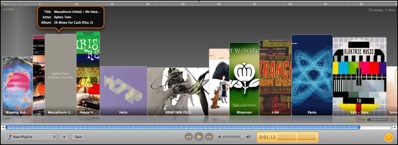Album art tag cloud
This nifty site takes your Last.fm or MusicMob profile and creates an embeddable cloud of album art (linked to artist pages) for your most played tracks. As with text clouds, the larger the image the more plays. I like.
Grid Music
I want to be a DJ. Those who know me know this to be true.
For about 18 months I’ve been playing with Ableton Live, a truly extraordinary application for creating music both linearly and on-the-fly. It is absolutely perfect for live entertainment. But last year, at its debut at our annual holiday party, it was (or rather, I was) a bit hobbled by the mouse-only access to its dizzying number of on-screen controls.
This year the problem is solved. I picked up what’s known as a control surface (basically a ton of hardware knobs and sliders) called the Novation Remote SL Zero which interfaces directly with the virtual controls of Ableton. Fine, great, I can mix and twiddle. But what was needed to put it over the top was the monome, that venerable, limited 8×8 controller that debuted to the infinite joy of audio geeks everywhere last year.
The monome is really a dumb device, a 64-button USB controller. But it has a loyal, smart following who’ve developed some amazing applications. One of them, called monogrid, let’s you chop up a song into discrete musical quanta so that they play out across the grid. Each button triggers that part of the sliced song, effectively turning the whole piece into a remixable unit — not unlike a turntable does, without the need to scratch across unwanted parcels (both a good thing and a bad thing).
Here’s my brother mucking around with Daft Punk’s “High Life”. Yes, his own metronome is a little off midway through, but that’s just proof that he’s really playing the thing.
Dorky? Yes. Crowd-pleasing? Absolutely.
Intense listening
Here’s an interesting idea for organizing your music library from my pal Len.
Instead of shoe-horning music into arbitrary and fluid genres or using the freeform grouping tag, Len uses the five-star rating field in iTunes as an intensity indicator. This breaks down generic distinctions entirely and focuses on the content of the music instead. It isn’t just BPM; determining a song’s intensity also factors in loudness.
One star is the most low-key: nearly all your ambient and new age tunes, some classical, some jazz, etc. Two stars would encompass things like ambient downtempo, much of the blues, etc. And so on up to five stars which contains your drill-and-bass and deathmetal.
But the point here is that the stars are not genre markers. Classical tracks could live in any one of the five star categories. As could most genres. You merely filter your music based on intensity. This makes sense to me because it represents how I feel before I put a song on. Rarely do I think, gee, I’d love to hear some smooth jazz right now. More often I am merely craving something downbeat and relaxed. This could be a country tune for all I care (though I certainly hope it isn’t).
More importantly this frees you from the shackles of taxonomy. Is that ambient or electronica? Can I call a mashup rock-and-roll if it contains a Mangione interlude? Etc.
This method is labor-intensive, no doubt. Instead of marking a whole album with a genre you have to listen to each track and note its intensity. But it can be done programatically. Tangerine is an OSX app that will crawl your library and pop the BPM into track metadata. It also allows you to create playlists by choosing intensity curves. You could imagine a smart playlist (actually I bet it would have to be an applescript) that assigned star ratings to all tunes in a certain BPM range.
How do you organize your library? Or, more specifically, what is your route into it? By artist, by genre, by intensity?
Kingdom of Pain
The Police played Wrigley Field last night, only the second concert allowed in the ballpark. It was a great show. Stewart Copeland is a genius and, apparently, a Cubs fan. Here’s a pretty good review.
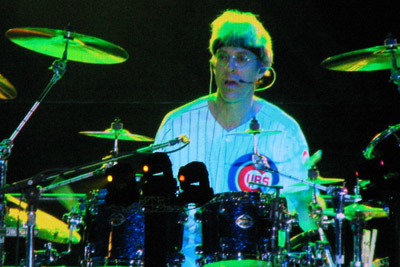
It was a bit odd seeing people so dressed up in the ballpark, cheering with no team on the field. It felt … wrong, somehow. Though it does continue my spate of unique outings at Wrigley this year.
More pics at Flickr.
Beyond shuffle
Had a thought.
Been listening to this on my iPod for a while (it is three hours long). There are sections in it that sound like the interference headphones and speakers get from incoming mobile signals. At first I thought it was my phone, but it isn’t. It’s in the recording, sorta like a watermark. Since it is a live recording perhaps it was picked up during the show.
It got me thinking about randomness in music recordings. Artists have been talking about this for decades, trying to approximate the variability of a live performance in a static recording. Basically it isn’t possible, though that which does exist tends towards empowering the listener to muck with the tracks. But what about merely giving the artist the ability to vary the song on a given listen?
You’d not need a new audio format, it seems to me. What about using the comments metadata section in an MP3 (or AAC, whatever) to include an executable chunk of code that could manipulate the actual audio stream? Obviously your player would need a plug-in of some sort to run the code, but that’s easy with the extensibility of most apps these days.
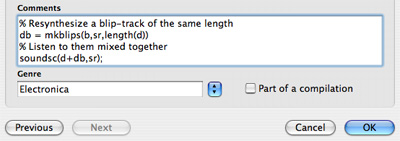
How would it work? Well, the song would play normally. The plug-in would look for comments and would be alerted by some string that announced that the contents were executable. If the plug-in were sophisticated enough it could do anything from simple effects (flanging, phasing, echoing) to actual audio insertions and overlays. You could imagine an online component that would go out and pre-fetch snippets or sounds that could be layered into the pre-recorded track. The key would be variability. It would not happen every time — or rather it would not have to happen every time. If it did, why not pre-record it? The idea is akin to apps today that live a dual existence on one’s machine and also, in part, online. If you didn’t have the plug-in the song would play normally.
It wouldn’t substitute for an artist’s creative freedom during a live show, but it would reinsert variability into the act of playback — something that’s been a part of the musical experience far longer than the era of recorded sound that we live in.
Update: Nick Nice, the artist behind the mix linked above, contacted me. He confirmed that the noise was in fact from his phone being too close to the mixer when an SMS was coming in.
This is what happens back at home when I travel
The inmates run the asylum (and my Last.fm account, apparently).
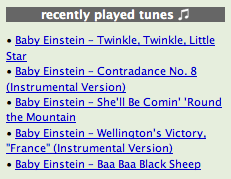
Most played music of the year
I end 2006 having played 17,677 tracks through iTunes since I started using Last.fm last year. Here are the top twenty artists for the last 12 months, in order.
Biosphere
Sufjan Stevens
Casino Versus Japan
Richie Hawtin
Midwest Product
Der Dritte Raum
Yagya
Plaid
Imogen Heap
Gary Numan
Mike Relm
Ladytron
Junkie XL
Boards of Canada
Ulrich Schnauss
Four Tet
Aphex Twin
Boom Bip (huh? haven’t listened to this in ages)
Girl Talk
Ryan Elliott
Interesting to compare the change since the 10,000 mark last March.
Merry Christmash
Looking for some interesting new holiday tunes? Look no further than Wayne&Wax. Wayne Marshall is one smart DJ. An ethnomusicologist by training, Wayne is currently a postdoc at the University of Chicago (lucky Chicago), a prolific blogger and masher.
Have a listen to Remix-mas and check the other free tracks listed from that post, including the new Christmas compilation from DJ BC of The Beastles fame. (For the love of all that is holy download “Imagine Santa” if you only can take one track. Goosebump material, that is.)
Other Wayne&Wax mashes of note include the Boston Mashacre, it’s followup Boston Smashacre and A Crunk Genealogy. The last was created for a course on Electronic Music he recently taught at the Harvard Extension School. The syllabus itself is a work of art, with custom mixes and a deep bibliography every week to illustrate major themes. Just superb.
Wayne also blogs at the riddim meth0d.
Dreamy Tangerine
You know that field in iTunes for beats-per-minute? Ever wondered what the hell it was good for? Well, now we know. Tangerine, a scrumptious little OSX app, will analyze your entire library — mine of some 12,000 tunes took 15 hours — and plop the BPM into track metadata — another 12 or so hours. So that’s nice: more complete metadata. But Tangerine actually allows you to do something useful.

Tangerine locally logs BPM and beat intensity. You can then construct playlists by selecting a frequency and intensity range and choosing a pattern.
The playlist view is nicely done. Songs are represented by their cover art and scaled vertically to represent BPM, horizontally to represent duration. You can of course save your playlists to iTunes.
This particular fruit will set you back $25.
A game called echo
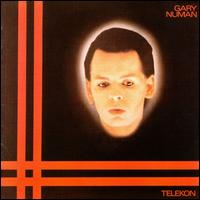
It’s the plight of the comeback musician who’s trying to do more than just cash in on old material. The new music is what motivates the artist personally, but it is the old stuff that fills the clubs and pays the bills. Gary Numan, who you might argue established the bridge between a moribund punk scene and new wave, has been back for about a decade. He’s all goth now — dark and Reznory — and he admits that he doesn’t want to play much but his new music. Yet, his fans still crave the old stuff. Not necessarily the hits (Cars, Are ‘Friends’ Electric?), but classics, the music that made synthesizers cool before a single Flock of Seagulls video ruined it all.
Well, Numan thinks he has a solution. He explains the concept of a classic album “mini-tour”:
For quite some time I have been concerned about those fans, most of whom have been with me for many, many years, that would like to see more older songs played live. As you are aware, my own desires have been to play less older stuff as each new album comes along, especially since ’94 when things got much heavier and darker. I have struggled to come up with a solution. One that enables me to continue to play predominantly newer material at the shows and yet doesn’t seem to be ignoring the wishes of those people that are a, not as interested in the newer stuff or b, do like the newer stuff but would still like to hear more older songs. So this is my first attempt at trying to do something that is some kind of a solution.
I think this is a great idea. Four shows only. Non-reworked versions of the original material from the album Telekon. If you’re a long time fan this clearly will give you palpitations of excitement. If you’re a new fan (and in Numan’s case he really does have a lot of ’em, believe it or not) then this is a chance to dial the wayback machine to the left and hear the roots of his current musical incarnation. Either way the shows are going to sell out. And Numan who “hate[s] nostalgia with a passion” can accommodate his fans without giving up the style that keeps him playing.
My bet is that when Numan finally sits down and tries to get the band to play the songs as they were back in 1979-1980-1981 he’ll learn some things too. Diving back that deeply into an old style might not be nostalgic, but I bet it’ll be enlightening. Like meeting a friend years after a falling-out. Only the next new album will tell.

